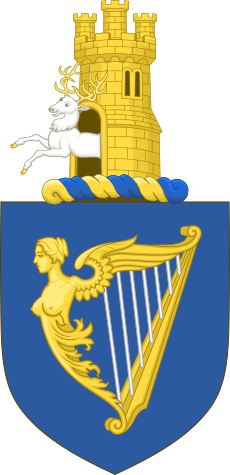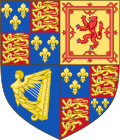Restoration (Ireland) facts for kids
The Restoration was a big event in 1660 when the monarchy (rule by kings and queens) came back to England, Scotland, and Ireland. Before this, these countries were a republic called the Commonwealth. This republic had formed after a series of wars.
After the Commonwealth started to fall apart in 1659, important leaders like General Monck worked to bring back the king peacefully. From May 1, 1660, King Charles II became the ruler of England, Scotland, and Ireland again. The word Restoration means both this event and the time period around it.
Contents
The Republic Ends in Ireland
When the government in England called "The Protectorate" collapsed in May 1659, the republic in Ireland also quickly began to break down. This republic had been set up by Oliver Cromwell.
Royalists, who supported the king, planned a rebellion in Ireland. They hoped to get leaders like Henry Cromwell and Lord Broghill to join them. However, their plan did not work out. Henry Cromwell left Ireland in June 1659.
Key Figures Take Action
Sir Theophilus Jones, a soldier who had served King Charles I, took control of Dublin Castle. He announced his support for the Parliament. Meanwhile, Sir Charles Coote took over Galway. Lord Broghill kept control in the area of Munster.
On January 9, 1660, a group of officers declared Edmund Ludlow a traitor, and he fled to England. Another leader, Hardress Waller, briefly took back Dublin Castle in February 1660. But he had little support and soon surrendered to Sir Charles Coote. Waller was arrested and sent to England. The officers in Dublin then supported General Monck.
The army was cleared of radical members. A special meeting, called the Convention Parliament, was set up. Coote wanted this Parliament to bring back the king. Broghill did not openly support the king until May 1660.
King Charles II Returns
In February 1660, Coote sent a message to King Charles II, who was in the Netherlands. He invited the king to come to Ireland. But the king felt it was better to reclaim England first. At the same time, Broghill also sent a message inviting the king to land in Cork. In March 1660, a document was published asking for the king's return. It asked for his forgiveness and promised a general pardon for past actions.
After important events in England, Charles was officially declared King of Ireland in Dublin on May 14. Everyone agreed to this. The Royal Irish Army was also brought back.
Life Under King Charles II
After 1660, the union of England and Ireland under the Commonwealth was seen as if it never happened. King Charles II ended the Convention Parliament in January 1661. He then called his first official Parliament in Ireland in May 1661.
In 1662, May 29 became a public holiday called Oak Apple Day. This day celebrated the king's return.
At first, Coote, Broghill, and Sir Maurice Eustace were the main political leaders. George Monck, Duke of Albemarle was given the important job of Lord Lieutenant of Ireland, but he did not actually take the position. In 1662, the 1st Duke of Ormonde returned as Lord Lieutenant of Ireland. He became the most powerful political figure during the Restoration period.
Religious Changes
Many Irish people felt hopeful because of the Declaration of Breda in 1660. In this declaration, King Charles said he would allow different religions. He stated that "no man shall be troubled for differences of opinion in matter of religion which do not disturb the peace of the kingdom." However, this promise was later reduced by laws passed between 1661 and 1665. These laws are known as the Clarendon Code.
The Church of Ireland was brought back as the official national church. On January 22, 1661, the King announced that all meetings by Catholics, Presbyterians, and other groups were illegal. Parliament later passed a law similar to one in England, called the Act of Uniformity 1666.
Even though the religious situation was not perfect for Catholics or Presbyterians, there was some freedom. Laws against them were not always strictly enforced. There was no law in Ireland like the strict Conventicle Act 1664 that was in England.
By 1666, Catholics and Dissenters (Protestants who were not part of the official church) were allowed to take their places in the Parliament of Ireland again.
Land Ownership Changes
One of the most debated issues after the Restoration was about land. Many people wanted to change the Cromwellian land settlement from 1652. Before the republic, Catholic landowners owned 60% of the land in Ireland. But much of this land was taken away after the Cromwellian conquest of Ireland in 1649–53.
Irish Protestants who helped bring back the king in 1660 expected to keep the lands they had bought. On the other hand, many Irish Catholic Royalists had supported King Charles I and Charles II during his exile. They now expected their lands to be returned. Other Catholic landlords who had lost their lands had been given new lands in Connacht. These landlords naturally wanted their original lands back.
New Laws for Land
A statement about land was made in 1660. This was followed by the Act of Settlement 1662. Since this did not solve everything, the Act of Explanation 1665 was passed. The result was a compromise. King Charles needed the continued support of former republicans. In the end, Catholics got back about 20% of the land.
King Charles II also gave some Irish land, taken from those who had executed his father, to his brother, the Duke of York. The Duke of York was Catholic. Charles also gave Irish land to his Catholic friend Barbara Villiers. He even gave her Catholic husband, Roger Palmer, an Irish title, Earl of Castlemaine.
The issue of land ownership was complex. For example, the Earl of Inchiquin had been a Protestant during the war but became Catholic in 1656. The Marquess of Clanricarde, a Catholic, lost his lands in the 1650s. But his lands were given back to his Protestant heir in 1662.
It became clear that the main people who gained land were the powerful English and Irish nobles, no matter their religion. The smaller landowners often lost out. For example, the Catholic Earl of Clancarty increased his lands from 82,000 acres in 1641 to 161,000 acres by 1670.
Ulster and the Tories
In Ulster, however, the land changes made by Cromwell were not reversed. Landless Catholics who fought against the Protestants who had bought their confiscated lands were called tóraidhe or tories. They were seen as Catholics who had lost their land and were seeking revenge against the new social order.
Some Ulster royalists were given land elsewhere. For example, Viscount Magennis lost his land in County Down. But King Charles II gave him 4,000 acres in counties Roscommon and Limerick in the 1670s. There were some exceptions. Randal MacDonnell, 1st Marquess of Antrim had also received land in Connaught in 1652. But he got all his County Antrim estates back in 1665. Sir Henry O'Neill and his brother Shane also had their lands taken. They were given new estates in County Mayo.
See also



